Events
The public programs of the exhibition A Hard White Body were conceived by Lotte Arndt in collaboration with Temporary Gallery, Cologne. They are part of a series of events entitled Disturbing Objects,Disquiet Objects. Going Beyond Classificatory Certainties taking place over both locations between September and December 2017.
At Bétonsalon - Center for Art and Research, Paris

- Aykan Safoğlu – still from Off-White Tulips, 2013, video, 24’.
Saturday, September 9, 3 p.m.
Precarious Homes with Jamika Ajalon, Candice Lin, Aykan Safoğlu
Screening: Aykan Safoğlu, Off-White Tulips (2013), 24’
A screening selected by Clara López Menéndez
James Baldwin’s statement that he only felt at home in places where he was a stranger testifies to his constitutive experience of un-belonging. His frequent journeys away from the United States, exile and travelling appear as precarious strategies to escape from racism and homophobia, without ever succeeding. His never fully satisfied longing for domestic stability was intimately related to the prevalent haunting racist discrimination surrounding him and his restless efforts to struggle against it. Beyond the United States, his stays in Paris, Istanbul and ultimately Saint-Paul-de-Vence came to be more or less hospitable stations in Baldwin’s life, enabling strong friendships to develop and providing temporary relief from his social and emotional suffering as well as collective and individual hardships.
In Baldwin’s writings, home appears as the precarious result of daring to radically engage in emotional bonds, challenging racial and sexual norms, categories, and taboos, which he describes as the “stink of love” in Giovanni’s Room. One of his last unfinished texts, The Welcome Table, was inspired by late night gatherings on the terrace of his house in Provence. Today threatened by the planned construction of luxury apartments, it gave shelter to an emerging community constituted by chosen alliances with close friends and former strangers, brought about through night-long discussions, confrontations, reconciliations and mutual care.
The artists participating in this public event opted to relate to Baldwin by elective affinity, to bring into resonance their own diasporic trajectories with the writer’s life-long wanderings, and to navigate ever shifting lines of racial and sexual attributions and desires.
3 p.m. Guided tour in the exhibition with Candice Lin

3.45 p.m. Welcome and introduction with Lotte Arndt, Lucas Morin (curators) and Regina Barunke (Temporary Gallery, Cologne)
4 p.m. Squatting Giovanni’s Room, an audio-visual anti-lecture by Jamika Ajalon

“The performative lecture will focus on the complexities of otherness as James Baldwin describes them in his writings. It concentrates on his works Notes of a Native Son, Another Country and Giovanni’s Room, and interweaves these fragments with an autobio-mythography: Baldwin not only reassured me, at a time when I felt most acutely alien. He also inspired me to look with a ‘futuristic’ eye, going beyond essentialized conceptions of identity. While the white hegemonic discourse, a simple ‘black versus white’ polarity but also the codes of blackness in use in large parts of the afrocentric rhetoric frequently excluded the experiences of queer and alternative People of Color, Baldwin’s multifaceted narratives generously articulate the complexities of inter-subjective identities. They thus provided a precarious home for the diasporic experience of mine – as a feminist Black American artist who has lived and worked in Europe for nearly 20 years.The audio-visual anti-lecture will dwell in these moving in-between spaces, bringing into resonance sound, philosophical notes, video loops and prose/ poetry all through an afro-futuristic lens.”
About Jamika Ajalon
Jamika Ajalon is an inter-disciplinary artist fortunate enough to have collaborated with many brilliant creatives across the globe. Mediums include written and spoken word, sound, photography, film, video, text, and music. She grew up in the United States, graduated from Goldsmiths, University of London, and lived and worked in Europe for more than 20 years.
4.45 p.m. break
5.00 p.m. screening of Aykan Safoğlu’s Kirik Beyaz Laleler (Off-White Tulips), TUR/GER 2013, Turkish with English Subtitles, 24’
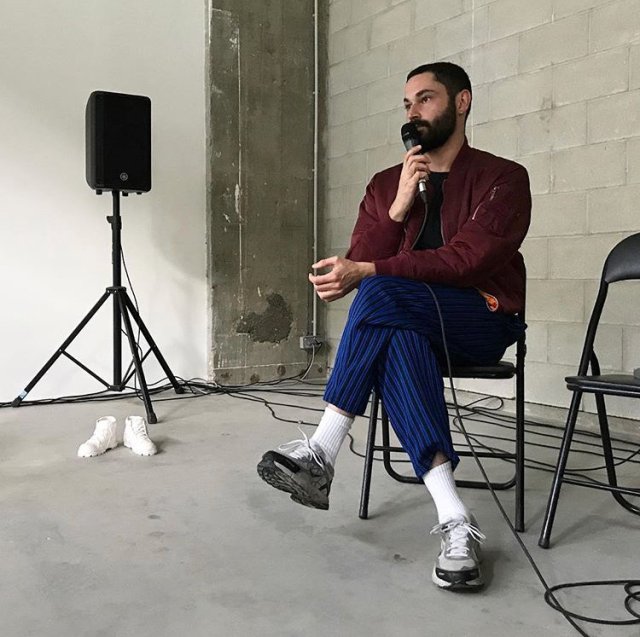
In his dense film essay, Aykan Safoğlu weaves together the narrative of James Baldwin’s time in Turkey with autobiographical elements. Between 1961 and 1971, the black American writer spent extended periods of time in Turkey, allowing him to get some space and to focus on his writing. Although he was warmly welcomed by Turkish friends, writers and artists, he also experienced racism and was violently beaten up during his stay. As Magdalena J. Zaborowska suggests in her study of Baldwin’s connections to Turkey, these stays allowed him to "re-imagine himself as a black queer writer and to revise his views of American identity and U.S. race relations as the 1960s drew to a close." Safoğlu himself grew up in Istanbul in the 1980s and 1990s. As an adult, he left Turkey to live in Berlin, a city providing wider possibilities for his aspirations as a queer artist, but also exposing him to the precariousness of short-term residence permits and racism in Germany.
Through archival material, the filmmaker intertwines Baldwin’s artistic evolution, representations of him by other artists, including one of the famous Beauford Delaney paintings and a Sedat Pakay photograph of the writer, and traces of his own childhood and teenage life. Resistance strategies to racism and homophobia in different contexts run through this account. While Safoğlu points to the aspiration for blondness and whiteness in Turkish and US-American popular culture in the 1990s, he is also becoming aware that his own sexual desire conflicts with heteronormative representations. On his analog copy stand, Safoğlu engages in a trans-historic dialog with Baldwin that allows the writer’s choices and experiences to resonate with his own.
Awarded at the International Short Film Festival Oberhausen in 2013.
The screening was selected by Clara López Menéndez.
About Aykan Safoğlu
In his art practice, Aykan Safoğlu forges relationships - friendships, even - across cultural, geographic, linguistic, as well as temporal boundaries. Beginning these friendships in his research, Safoğlu queers, complicates and revises the histories of famous figures such as writer James Baldwin, or artists Paul Thek and Ulay, by weaving them together with his own. Working across film photography and performance, he makes open-ended enquiries into cultural belonging, creativity and kinship.
Born in Istanbul in 1984, Safoğlu studied at Universität der Künste, Berlin, and Milton Avery Graduate School of the Arts at Bard College, Annandale-on-Hudson, and was resident at SAHA studio, Rijksakademie van Beeldende Kunsten in Amsterdam. He has participated in group exhibitions such as Father Figures are Hard to Find, nGbK, Berlin (2016); THE BILL: For Collective Unconscious, Artspace, Auckland, (2016); Home Works 7, Ashkal Alwan, Beirut (2015), and has screened at various international film festivals. He lives and works in Berlin.

Saturday, October 21, 3 p.m.
Bathing in Contagious Liquids with Élisabeth Lebovici, Clara López Menéndez, Petra Van Brabandt
Screening: Vladimir Ceballos, Maldito sea tu nombre libertad
(1994), 61’
A screening selected by Clara López Menéndez
In Candice Lin’s exhibition, circulating liquids connect animate and inanimate bodies and bring into resonance apparently distant (his-)tories. The Atlantic Ocean, present throughout the narratives of the exhibition, holds the memory of the enslaved Africans who were thrown overboard for monetary compensation. The same ocean allowed James Baldwin to spend years far enough from the USA to be temporarily less exposed to its racist structures, and focus on writing.
Liquids are constitutive of bodies, and simultaneously dissolve their delimitations to each other. In the exhibition space, a mixture of distilled piss, water from the Seine river, and infused plants is pumped through a sprinkling system that keeps the unfired porcelain room moist. It produces a humid smelly air that fills the room and involves–indiscriminately of their animate status–all the present bodies.
The invited speakers engage with liquids and artistic practices, specifically in the context of the AIDS epidemic, as well as with queer and feminist practices in the field of art, and beyond.
3.00 p.m. Guided tour of Candice Lin’s exhibition A Hard White Body with the curators
3.30 p.m. Welcome and introduction by Lotte Arndt and Lucas Morin (curators of the exhibition)
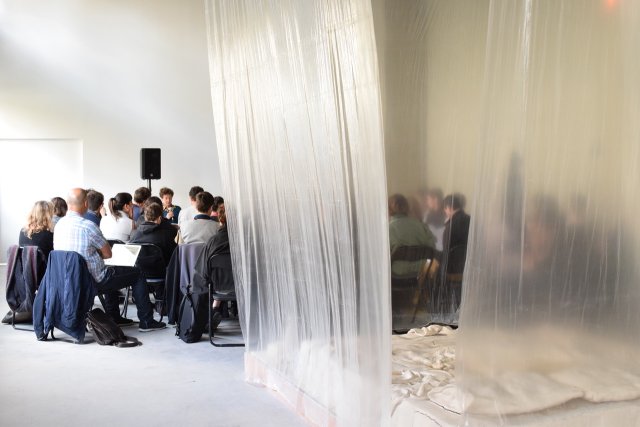
3.45 p.m. Petra Van Brabandt: To Heat by Melting
What do Cabanel’s Birth of Venus, Klein’s Anthropometry, or Kusama’s Self-Obliteration have in common? What relates Picasso’s Woman Pissing to Marlene Dumas’ watercolours and Tejal Shah’s Between the Waves? All these art works are deploying wet aesthetics. This refers to an aesthetic experience that is realized by the perceptual interaction with wetness: an aesthetics that affords a strong erotic or sexual resonance and that produces specific visceral effects in the viewer’s body.
Petra Van Brabandt is a philosopher; she teaches semiotics, art theory, and cultural criticism at St Lucas School of Arts, Antwerp, Belgium. She is member of the research group Art&Narrativity. Her research focuses on sociopolitical dimensions of art. She writes and lectures about art and feminism, pornography, postcolonialism, and laziness. Her current research concerns wet aesthetics in art and pornography.
4.30 p.m. screening of Vladimir Ceballos’ Maldito sea tu nombre, libertad, USA, 1994, 61’. Spanish with English subtitles.

The postwar confrontation between the communist and capitalist blocks came to its end in 1989. While Cuba, heavily dependent on funding from the Soviet Union, was destabilized economically, Fidel Castro’s government reinforced so-called socialist values. These were said to be in sharp contrast with the musical and aesthetic preferences of young Cuban rock enthusiasts, called roquer@s, who were considered by the regime to embody ideals of individualism and disidencia [dissidence] and were severely repressed as a result. In response to the harsh police harassment of this subculture, a significant number of its members decided to deliberately contract HIV in order to escape mandatory military service, forced work, or incarceration. They lived their short lives inside the sanatoria created by the Cuban government to contain the epidemic. Maldito sea tu nombre, libertad is a precious document acknowledging that this phenomenon was in response to political repression. Shot secretly in the Cuban province of Pinar del Río over a weekend in 1994 using borrowed equipment, this film presents one of the few existing documents of this complex social tragedy.
Vladimir Ceballos is a film editor based in Providence, Rhode Island, USA.
The screening was selected by Clara López Menéndez who introduces the film.
5.30 p.m. Élisabeth Lebovici and Clara López Menéndez in conversation around Vladimir Ceballos’ film, the "precious liquids" analyzed by Lebovici in her recent book What AIDS has done to me (Les presses du réel, 2017), and the porosity, fragility and relatedness of bodies.
Élisabeth Lebovici is a historian, art critic, activist and writer. She has been a journalist at Libération, writing in its cultural column from 1991 to 2006. She wrote Femmes Artistes/Artistes Femmes (Hazan, 2007) in collaboration with Catherine Gonnard and runs the blog http://le-beau-vice.blogspot.com.
In 2017, she published Ce que le sida m’a fait/What AIDS has done to me (Paris, Les presses du réel), an intimate and political account of intersections between art and activism, seen through the AIDS epidemic in the 1980s and 1990s in France and the United States.
Clara López Menéndez is an art worker practicing in the fields of curation, art criticism, pedagogy and performance. She is currently a visiting artist at the California Institute of the Arts. She directed the BOFFO Fire Island Art Residency in 2014 and 2015, and is the director of the experimental film platform Dirty Looks LA. Her writing has appeared in Mousse, Art News, Bomb, Little Joe, and Girls Like Us. She’s currently working on the project A new job to unwork at which will culminate in an exhibition at Participant Inc. in NYC in the summer of 2018.
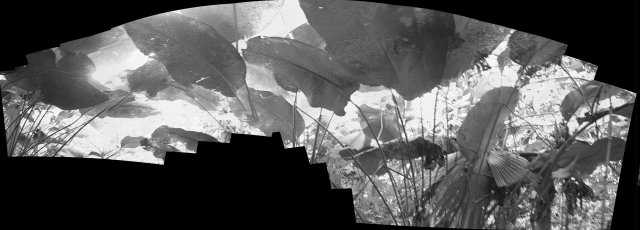
Saturday, November 25, 4 p.m.
IN ANY (WAY,) SHAPE OR FORM with performances by Géraldine Longueville (Paris) and Simon Speiser (Berlin), invited by Marie Sophie Beckmann (Goethe-Institut Fellow 2017)
A single sock and a pair of men’s underpants are solidified in their crumpled state as porcelain objects. Plants, blossoms and herbs appear as drawings, they grow out of sculptures and are hung up to dry. Hair and dust stick to the moist surface of the porcelain bedroom, mold is growing, puddles of distilled piss are forming on the sheets. A disembodied voice inhabits the space. Moving images appear on wafting, semi-transparent sheets.
Candice Lin’s exhibition A Hard White Body, in itself an unstable sculptural ecosystem, visualizes the ongoing (re-)appearing, (re-)connecting and (re-)shaping of liquids, bodies, materials, and narratives.
Picking up on these processes, the performative works by the artists Géraldine Longueville and Simon Speiser explore moments of exchange, translation and transformation. IN ANY (WAY,) SHAPE OR FORM is an afternoon of sharing water and stories (of plants and places) amidst the installation by Candice Lin.
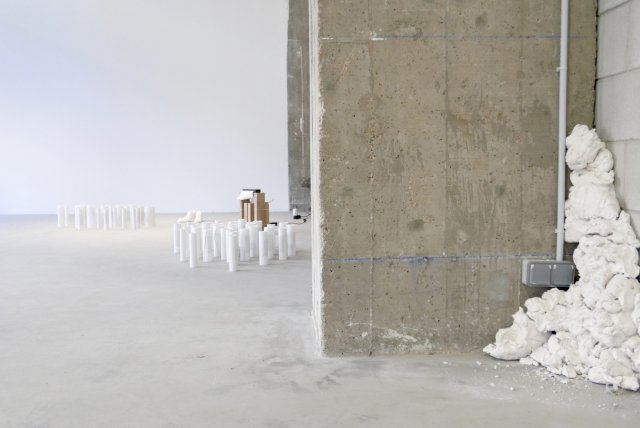
4 p.m. A State of Water. Performance by Géraldine Longueville
*in French
Each plant derives from a source, carries a story, contains knowledge. Géraldine Longueville offers a degustation of plant and herb infused waters in which these stories are told, the sources revealed, and the knowledge shared. The taste? Bitter.
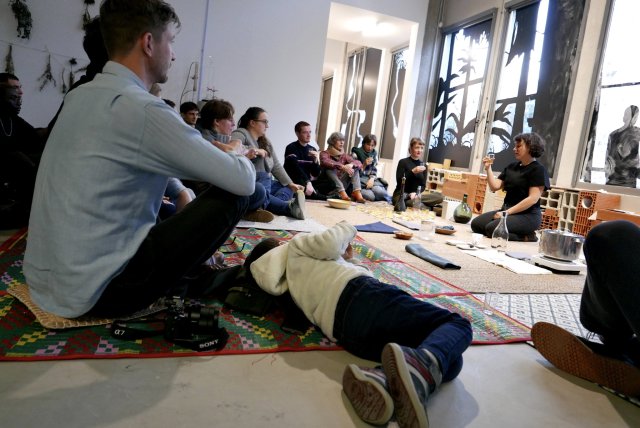

Géraldine Longueville lives and works in Paris. Her practice started in 2005 as a curator by exploring formats of the exhibition. She nurtured the artists’ inventiveness by creating flexible and multiple modes of exhibiting and sharing it with an audience in the form of a show, a residency, a song, a poem, or a meal. From 2011 to 2013 she collaborated with the artists David Bernstein and Jurgis Paskevicius under the name Juguedamos. In 2014 she founded Black garlic a studio for art and gastronomy run with the chef Virginie Galan and the graphic designer Commune. Since 2015 she collaborates with La Piscine, a choreographic project made for a single audience with multiple tools, initiated with the artist Myriam Lefkowitz. Since then she makes drinks and potions that question notions of welcoming, mediation and transmission. She is currently working on a tailor made bitter commissioned by the Contemporary Art Center CAC Bretigny for its collection in 2018.
5 p.m. Performance by Simon Speiser
*in English
"In the forest, the act of love builds a bridge between the species as the flora uses the agility of the fauna to impregnate from a distance" – Simon Speiser reads from a new short story with a Sci-Fi twist about loving trees, while transferring a natural landscape into a black and white digital print on site.
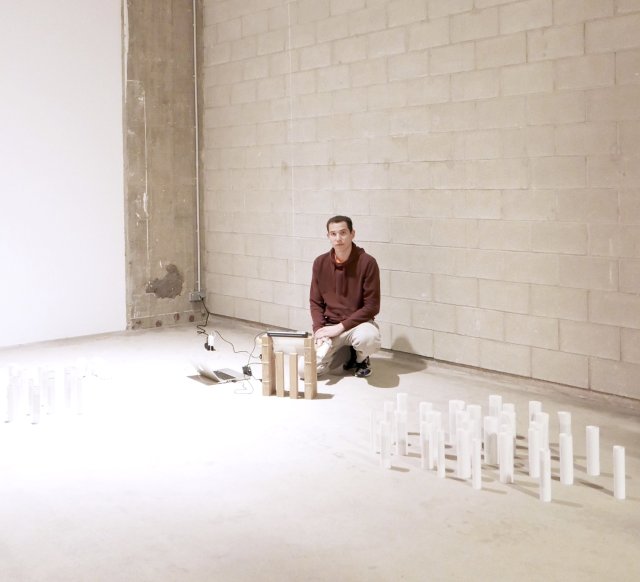
Simon Speiser (b. 1988 in Regensburg, Germany) is currently based in Berlin. Working with sculpture, text, video, and prints, he "draws experimental fictions out from a beyond only recently perceivable, where art embarrasses science fiction, where sculpture penetrates fantasy, and the reader must encounter perhaps the strangest recognizable texts yet concocted outside her own head." (Mark Von Schlegell). Simon Speiser studied Fine Arts at the Akademie der Bildenden Künste, Stuttgart with Prof. Christian Jankowski and Prof. Alexander Roob. In 2014, he graduated from the Staatliche Hochschule für bildende Künste Städelschule, Frankfurt/Main, having studied with Willem de Rooij, Michael Krebber and Mark von Schlegell. Over the last four years he has participated in several group and solo shows in institutions, galleries and project spaces such as the Frankfurter Kunstverein; MMK Museum für moderne Kunst Frankfurt am Main; Alexander Levy Gallery, Berlin; Croy Nielsen, Berlin; Oracle, Berlin; and MMCA Seoul.
IN ANY (WAY,) SHAPE OR FORM is organized in the context of the Goethe-Institut Fellowship 2017.
The Goethe-Institut and Villa Vassilieff created together in 2016 a research residency program for German curators. Every year, a curator is invited to develop a research project at Villa Vassilieff, in partnership with a German institution and has the possibility to dialogue with several international institutions (museums, archives, schools, civilians. This grant is attributed in parallel to the Focus programs, organized each year by the Goethe-Institut in a German city or a Land.
Marie Sophie Beckmann (b. 1989 in Bremen, Germany) is Goethe-Institut Fellow 2017. She lives and works as a writer and curator in Berlin. She received her MA in Curatorial Studies at the Goethe-Universität and Staatliche Hochschule für bildende Künste – Städelschule in Frankfurt/Main in 2016 with a thesis on the Cinema of Transgression. In 2015, she co-founded the curatorial initiative EVBG which focuses on contemporary film, video art and feminist art practices. Marie Sophie Beckman is a PhD candidate in the post graduate program Konfigurationen des Films (Configurations of Film) at the Goethe-Universität in Frankfurt/Main.
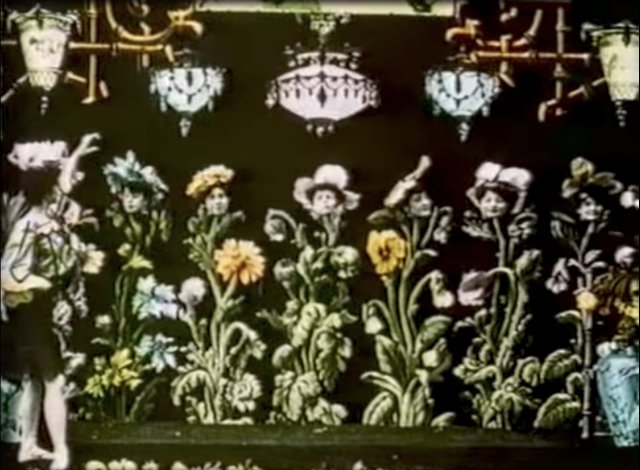
- Gaston Velle – still from Living Flowers (Les fleurs animées), 1906
Saturday, December 2, at 3 p.m.
Stowaways with Samir Boumediene, Teresa Castro, Laura Huertas Millán
*in French
At a time when botany was an integral part of transatlantic explorations, the young peasant and herbalist Jeanne Baret disguised herself as the valet of her mentor and lover, the botanist Philibert Commerson, and boarded L’Étoile, one of the ships of the Bougainville expedition (1766-1769). An imperial traveler, this key figure in Candice Lin’s exhibition A Hard White Body occupies a troubled and ambiguous place: with her journey, she claimed the possibility of a life then denied to women. However, the journey at the same time contributed to an undertaking of conquest and the colonization of knowledge by the classification of the collected plants found in the Americas and on the islands of the Indian Ocean.
Baret’s activity was at the heart of the connection between plants and empire, between Western concepts and masculine domination and cunning resistance, multiple and practical. Establishing transatlantic connections, exploratory journeys were never one-way traffic. On the contrary, among the stowaways were, in addition to human beings, traveling in secret or under the guise of a borrowed identity, seeds, bacteria and viruses, plants and animals that spread on both sides of the ocean. Indomitable powers, these bodies without passports or inventory record eluded from the will of mastery, were scattered, encrusted and multiplied in interaction with their new homelands.
Samir Boumediene: On magic love
"Tobacco, coca, cinchona, cocoa, guaiac, peyote, poisons, abortives... From 1492 to the middle of the eighteenth century, Europeans in America appropriated countless medicinal plants. Through scientific expeditions and interrogations, they collected the knowledge of Native Americans or enslaved populations to market drugs and develop with them the first health policies. At the same time, inquisitors and missionaries forbade the ritual use of certain plants and saw themselves confronted by the resistance of healers. Botany, fraud and witchcraft: between the American forests and the courts of the Old World, the study of Samir Boumediene tells the European expansion as a colonisation of knowledge."
Samir Boumediene is a historian, researcher at the CNRS (IHRIM, ENS Lyon). He is author of The Colonization of Knowledge. A History of Medicinal Plants of the New World (1492-1750), Editions des mondes à faire, 2016.
Teresa Castro: Cinema and some of its vegetable fables
In cinema, plants come to life: trees dance, mushrooms quiver and flowers whirl. Thanks to its expressive resources and its fabulative power, cinema – the medium of modernity and the avatar of objectivity – thus becomes, paradoxically, the diviner of the "vegetable soul", upsetting the borders of life and engendering more or less surprising intentionalities. Starting with some very diverse examples, from science cinema to B-rated movies, this presentation explores some of the fables fabricated by cinema, focusing on how they sometimes associate plants with the feminine.
Teresa Castro is a lecturer in Film and Audiovisual Studies at the Sorbonne Nouvelle - Paris 3 University. She is a former postdoctoral researcher at the Musée du quai Branly and at the Berlin Max Planck Institute for the History of Science, she published The Cartographic Thinking of Images. Cinema and visual culture (2011) and co-directed with Maria do Carmo Piçarra (Re) imagining African Independence: Film, Visual Arts and the Fall of the Portuguese Empire (2017). Her current research focuses on the links between cinema and animism.
Laura Huertas Millán: Journey to a Land Otherwise Known, 2011, 23 min., color, stereo, DCP.
Screening and discussion with the artist on her film
Accompanying imperial conquests, stories of natural and ethnographic exploration trips contributed to the invention of the colonized territories. The recurrence of certain tropes, an almost universal dramaturgy that let this new world emerge for Westerners, shows how much the expectations of imperial travelers shaped their object.
Journey to a Land Otherwise Known is based on a broad body of these stories of exploration and questions the persistence of exotic imaginaries in contemporary cinema. It is entirely shot in an equatorial greenhouse in Lille, built in 1970 by the architect Jean-Pierre Secq. Just as it was up to the Armchair Ethnologists to canonize knowledge about colonized lands and their inhabitants, the imaginary of the Americas is composed here through narratives that prefigure the gaze. The film invests this imaginary and immediately destabilizes it by introducing shifts, camouflages as well as minor and major irritations.
Laura Huertas Millán (1983) is a French-Colombian artist and filmmaker. A graduate of the Fine Arts School of Paris and Le Fresnoy, she holds an art practice-based PhD on "ethnographic fictions" (ENS Ulm, Beaux-Arts de Paris). In 2014, she was a visiting fellow at the Sensory Ethnography Lab. Between 2014 and 2017, she was a fellow at the Film Study Center at Harvard University.
Her films circulate in both art and cinema venues. Sol Negro (2016), her latest film, was awarded at FIDMarseille (France), Doclisboa (Portugal) and Fronteira Film Festival (Brazil).
Laura Huertas Millán´s hyphenated works intertwine genres, crossing documents and different forms of fictions. Using writing as an extension of filmmaking, she has recently published in Spike Art Quaterly, in collaboration with Raimundas Malasauskas.
At Temporary Gallery, Cologne
Friday, October 13, 7 p.m.
Matter in Process: Erasures and Resurgences with Mathieu K. Abonnenc, Susanne Leeb
Screening : Mathieu K. Abonnenc, An Italian Film. Africa Addio. First Part: Copper (2012), 27’
Friday, November 3, 7 p.m.
Border Crossers. On Strange Growth and Collections in Turmoil with Pauline M’barek, Tahani Nadim, Kerstin Stoll
Disturbing Objects, Disquiet Objects. Going Beyond Classificatory Certainties is sponsored by Perspektive - Fund for Contemporary Art and Architecture, a program initiated by the Bureau for Visual Arts of the Institut français Germany.
-
info document (MP3 - 32.8 MiB)
-
info document (MP3 - 35 MiB)
Share